Adding Movement Speed Back to Flying Dinos Ark
![]()
Quetzal
1.0
May 24, 2018
Spawn Command
cheat summon Quetz_Character_BP_C
or
cheat SpawnDino "Blueprint'/Game/PrimalEarth/Dinos/Quetzalcoatlus/Quetz_Character_BP.Quetz_Character_BP'" 500 0 0 35
Variant Tek Quetzal
cheat summon BionicQuetz_Character_BP_C
or
cheat SpawnDino "Blueprint'/Game/PrimalEarth/Dinos/Quetzalcoatlus/BionicQuetz_Character_BP.BionicQuetz_Character_BP'" 500 0 0 35
Variant Malfunctioned Tek Quetzal
cheat summon BionicQuetz_Character_BP_Malfunctioned_C
or
cheat SpawnDino "Blueprint'/Game/PrimalEarth/Dinos/Quetzalcoatlus/BionicQuetz_Character_BP_Malfunctioned.BionicQuetz_Character_BP_Malfunctioned'" 500 0 0 35
Variant Malfunctioned Tek Quetzal (Gauntlet)
cheat summon BionicQuetz_Character_BP_Malfunctioned_Gauntlet_C
or
cheat SpawnDino "Blueprint'/Game/Genesis/Dinos/MissionVariants/Gauntlet/Lunar/BionicQuetz_Character_BP_Malfunctioned_Gauntlet.BionicQuetz_Character_BP_Malfunctioned_Gauntlet'" 500 0 0 35
Variant Malfunctioned Tek Quetzal (Retrieve)
cheat summon BionicQuetz_Character_BP_Malfunctioned_Retrieve_C
or
cheat SpawnDino "Blueprint'/Game/Genesis/Dinos/MissionVariants/Retrieve/Lunar/BionicQuetz_Character_BP_Malfunctioned_Retrieve.BionicQuetz_Character_BP_Malfunctioned_Retrieve'" 500 0 0 35
Variant R-Quetzal
cheat summon Quetz_Character_BP_Rockwell_C
or
cheat SpawnDino "Blueprint'/Game/Genesis2/Dinos/BiomeVariants/Quetz_Character_BP_Rockwell.Quetz_Character_BP_Rockwell'" 500 0 0 35
Variant R-Quetzal (Summoned)
cheat summon Quetz_Character_BP_Rockwell_Summoned_C
or
cheat SpawnDino "Blueprint'/Game/Genesis2/Dinos/Summoner/SummonedDinos/Quetz_Character_BP_Rockwell_Summoned.Quetz_Character_BP_Rockwell_Summoned'" 500 0 0 35
Variant R-Quetzal (Gauntlet2)
cheat summon Quetz_Character_BP_Rockwell_Summoned_C
or
cheat SpawnDino "Blueprint'/Game/Genesis2/Missions/ModularMission/Gauntlet2/STA/Dinos/Quetz_Character_BP_STA.Quetz_Character_BP_STA'" 500 0 0 35
Data
No
Baby Time
13h 13m 39.048s
Juvenile Time
2d 4h 54m 36.19s
Adolescent Time
2d 18h 8m 15.238s
Total Maturation Time
5d 12h 16m 30.476s
Breeding Interval
18h - 2d
Habitat


This variant spawns only during an Event
Common Rare
Untameable Cave
The Quetzalcoatlus (ket-sull-ko-at-luss), more commonly known as Quetzal or simply Quetz, is one of the creatures in ARK: Survival Evolved.
Contents
- 1 Basic Info
- 1.1 Dossier
- 1.2 Behavior
- 1.3 Appearance
- 1.4 Color Scheme and Regions
- 1.5 Tek Quetzal (Variant)
- 1.6 Drops
- 1.7 Base Stats and Growth
- 1.7.1 Wild Stats Level-up
- 2 Taming
- 2.1 Preferred Food
- 2.2 KO Strategies
- 2.2.1 50/50 Glitch
- 2.2.2 Hit and Run
- 2.2.3 1-Player Tapejara Strategy
- 2.2.4 2-Player Tapejara Strategy
- 2.2.5 Argentavis Solo Tame
- 2.2.6 Griffin Solo Tame
- 2.2.7 Wyvern Solo Tame
- 2.2.8 Parachuting
- 2.2.9 Argentavis & Scorpion/Pachy/Titanoboa Strategy
- 2.2.10 Quetzal Cage Strategy
- 2.2.11 Grappling Hook Strategy
- 2.2.12 Argent Grab Strategy
- 2.2.13 Chain Bolas
- 2.2.14 Snow Owl Strategy
- 2.2.15 Revival Platform Strategy
- 3 Combat
- 3.1 General
- 3.2 Strategy
- 3.3 Weaponry
- 3.4 Dangers
- 3.5 Weakness
- 4 Utility
- 4.1 Roles
- 4.2 Collectibles
- 5 Flight
- 5.1 Carrying
- 5.1.1 Carry-able Creatures
- 5.1.2 Non-Carry-able Creatures
- 5.1 Carrying
- 6 Spotlight
- 7 Changelog
- 8 Notes/Trivia
- 9 Gallery
- 10 References
Basic Info [ ]
Dossier [ ]
This section is intended to be an exact copy of what the survivor Helena Walker, the author of the dossiers, has written. There may be some discrepancies between this text and the in-game creature.

"
Species
Quetzalcoatlus conchapicem
Time
Late Cretaceous
Diet
Carnivore
Temperament
Skittish
- Wild
From afar, it's hard to believe that Quetzalcoatlus is one of the largest avians on the island. It shares a similar silhouette with the Pteranodon, and nests near the absolute highest peaks. Upon closer inspection, though, Quetzalcoatlus is an enormous creature of tremendous power. I find it strange that such a large, imposing beast would be so skittish. Unlike other creatures of its size, it is more likely to flee than fight. I suppose the decision to flee from any trouble keeps the species alive on an island with so many dangerous predators. But then how does it eat enough to sustain its massive size?
- Domesticated
Tamed Quetzalcoatlus have a very specific role on the island. Too slow to be an efficient local transport, and too weak to be an effective warbird, the tribes I have encountered tend to employ it as a mass carrier. Quetzalcoatlus is primarily used by these masters of the skies to safely carry vast quantities of supplies, creatures and human cargo from one base to another without tiring.
„
Behavior [ ]
The Quetzal is constantly flying and flees if attacked. In casual flight, Quetzal tends to fly somewhat slowly. However, if startled, they can move at surprisingly fast speeds — comparable to that of a pteranodon's sprint — in an attempt to escape. After a few seconds it will resume normal speed.
Appearance [ ]
Quetzalcoatlus is the largest flying animal yet found on the island. A gigantic, long-necked crested pterosaur, it dwarfs the much more common Pteranodon. These creatures are solitary and far-ranging, flying all over the map to roost and feed. They are carnivorous, feeding mainly on fish and small game taken from the ground. In addition, they scavenge.
Color Scheme and Regions [ ]
This section displays the Quetzal's natural colors and regions. For demonstration, the regions below are colored red over an albino Quetzal. The colored squares shown underneath each region's description are the colors that the Quetzal will randomly spawn with to provide an overall range of its natural color scheme. Hover your cursor over a color to display its name and ID.
This information can be used to alter the Quetzal's regions by entering cheat SetTargetDinoColor <ColorRegion> <ColorID> in the cheat console. For instance, cheat SetTargetDinoColor 0 6 would color the Quetzal's "wing membrane" magenta.
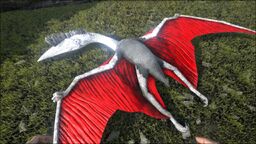
Region 0:
Wing Membrane
8
13
14
19
20
21
22
23
24
25
26
27
32
33
34
35
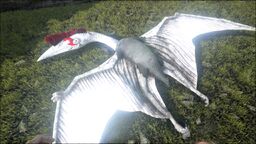
Region 1:
Crest
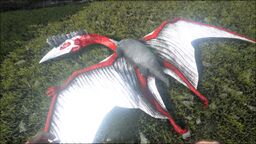
Region 2:
skin
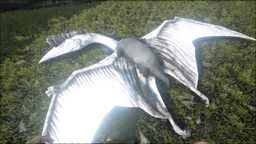
Region 3:
Freckles
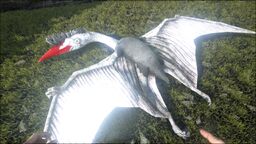
Region 4:
Beak
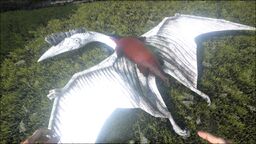
Region 5:
Body Feathers

Region 0:
Main color
21
28
42
43
49
50
51
52
55
56
62
63
64
65
66
71
77
78
82
92
93
99

Region 1:
Beak
10
11
23
32
39
40
42
43
44
49
50
51
52
55
66
67
74
75
76
77
95
100

Region 2:
Accent color
10
11
23
25
28
30
32
39
40
42
43
44
49
50
51
52
55
66
67
74
75
76
77
91
94
95
100

Region 3:
Accent color
10
11
23
25
28
30
32
39
40
42
43
44
45
47
48
49
50
51
52
53
54
55
66
67
69
70
74
75
76
77
84
85
91
94
95
100

Region 4:
Secondary color
21
28
42
43
49
50
51
52
55
56
62
63
64
65
66
71
77
78
82
92
93
99

Region 5:
Tertiary color
21
28
42
43
49
50
51
52
55
56
62
63
64
65
66
71
77
78
82
92
93
99
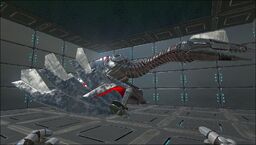
Region 0:
Wing Highlights
5
6
8
13
14
23
28
29
30
31
36
49
49
51
53
54
55
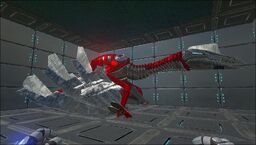
Region 1:
Body Main
5
6
8
13
14
23
28
29
30
31
36
49
49
51
53
54
55
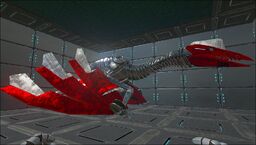
Region 2:
Head and Wings
5
6
8
13
14
23
28
29
30
31
36
49
49
51
53
54
55

Region 3:
Joints
5
6
8
13
14
23
28
29
30
31
36
49
49
51
53
54
55
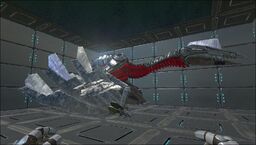
Region 4:
Underbelly
5
6
8
13
14
23
28
29
30
31
36
49
49
51
53
54
55

Region 5:
Emissives
Tek Quetzal (Variant) [ ]
The Tek Quetzal is a creature that was permanently added to the game in the Extinction Chronicles V event. It is a unique alternate of the original Quetzal, and is purely made of Tek. Unlike the original, they spawn at a 5% rate at a 20% higher level than usual.
Drops [ ]
Base Stats and Growth [ ]
| Movement [u/s] | Base Speed | Sprinting Speed | Stamina | ||||
|---|---|---|---|---|---|---|---|
| Wild | Tamed1 | Tamed2 | Wild | Tamed1 | Tamed2 | ||
| Walking | 360 | ? | ? | N/A | N/A | N/A | 7 |
| Swimming | 300 | ? | ? | ? | ? | ? | ? |
| Flying | 500 | ? | ? | 1596 | 950 | 1296.75 | 0.185 |
- 1These are the base speeds of the creature at 100% Movement Speed.
- 2These are the speeds of the creature tamed and non-imprinted.
- For a comparison of the speeds of all creatures, see Base Creature Speeds.
Wild Stats Level-up
Type in values of a wild creature to see on which stats it's emphasized. Green values on a high-level creature are very good for breeding. If you have already tamed your creature you can try to recover the breeding stats with an external tool.[1]
Quetzal
The stat-calculator does not work in the mobile-view, see here for alternatives: Apps
Note that after the creature is tamed it gets bonuses on some stats depending on the taming effectiveness. This makes it hard to retrieve the levels on a tamed creature, so this tool is only for wild ones, but gives a first impression, how well the stats are distributed.
Taming [ ]
Note that the values are for optimal cases, always bring extra supplies!
For a level-dependent count of resources needed, try an external taming calculator.
Ingredients for ![]() Exceptional Kibble: 1 ×
Exceptional Kibble: 1 ×![]() Extra Large Egg, 5 ×
Extra Large Egg, 5 ×![]() Fiber, 1 ×
Fiber, 1 ×![]() Focal Chili, 10 ×
Focal Chili, 10 ×![]() Mejoberry, 1 ×
Mejoberry, 1 ×![]() Rare Flower, 1 ×
Rare Flower, 1 ×![]() Water
Water
Preferred Food [ ]
-
 Exceptional Kibble
Exceptional Kibble -
 Raw Mutton
Raw Mutton -
 Raw Prime Meat
Raw Prime Meat
KO Strategies [ ]
A wild Quetzal never stops flying, so knocking one unconscious solo is very difficult if you do not already have access to a tamed Quetzal. Naturally, if you already have a first Quetzal, the second is quite easy - see the "Quetzal Cage Strategy" below.
If you don't already have access to a tamed Quetzal, the following strategies may be of use. Be sure not to knock out the Quetzal above water or it could drown.
It should also be noted that Rare Flowers do not work on a Quetzal.
ALT Grappling Strategy
Use the Argy Grappling strategy but instead grapple the Quetzal so you'll hold on to it. DON"T FORGET TO WHISTLE THE MOUNT TO FOLLOW YOU.Bring your taming method and food, parachute(for when you fall). Find a Quetzal, get close to it, dismount and grapple the Quetzal, reel in, and shoot it. Un-grapple and use the parachute. Tame as usually. This method also works for crystal wyverns but the passive way.
50/50 Glitch [ ]
The 50/50 glitch is a well-known and highly impactful bug that effects the Quetzal. This particular bug makes any startled Quetzal (meaning, one you were about to tame) travel to coordinates 50, 50 on any map. While this path is interrupted by the erratic circling and looping of the Quetzal's typical escape routine, the Quetzal eventually arrives at 50, 50 and will wander around from that area until brought down to tame or scared back again. It will likely not leave the 50, 50 area simply due to its slow, idle flying and tendency to not fly very far in any one direction for a surprising amount of time. This can pose problems for taming: the Island's 50, 50 is especially dangerous with a host of large carnivores (Rexes, Spinos, Terror Birds, and Purlovias, to name a few) crawling around that general area and Ragnarok's 50, 50 is surrounded by a mountainous, frigid area with high, rocky slopes where the Quetzal can get stuck while escaping, thus not reaching the 50, 50 at all. While a slope-stuck Quetzal makes taming a lot easier, when knocked out, it drops significantly down the slope and there might be predators below waiting for an easy meal.
Take careful note of this as you work with the taming strategies for a first Quetzal mentioned below.
Hit and Run [ ]
Using a Longneck Rifle, Shocking Tranquilizer Darts and a fast flying mount. Wait until a Quetzal flies close to a mountain or to the ground, land and then quickly shoot it with the darts. When it takes off in panic jump back on your mount and follow it, and repeat this process until its gets knocked unconscious. While this is a fairly basic strategy, it can be very time consuming, expensive (Tranquilizer Darts require Simple Rifle Ammo to make, which are the second most expensive ammo in the game to make themselves) and potentially dangerous as you must land nearly immediately in order to keep up with the Quetzal's torpor. In addition to this, you will have little control over where it lands, possibly putting it in the way of predators. Be careful that nothing attacks the Quetzal while it's unconscious.
1-Player Tapejara Strategy [ ]
For this method all you need is a Tapejara as well as Longneck Rifle with Tranquilizer Darts or a Crossbow with Tranquilizer Arrows (for mobile, toxicant arrows are recommended). Board the drivers seat to fly and find a Quetzal. Once found, find a place to land and board the front seat of the Tapejara Saddle. Once in the front seat you will be able to control the Tapejara with whistle commands allowing you to follow the Quetzal while also using a weapon to knock it out. Here is a video showing how this is done.[2]
2-Player Tapejara Strategy [ ]
All you need is a tribemate, a Tapejara, and a method of tranquilizing. Put many points into Stamina to maximize the time available before you're forced to land. Make sure you have some Raw Meat on the Tapejara as well. Get your tribemate to mount onto the back part of a Tapejara Saddle and equip your method of tranquilizing (e.g. Longneck Rifle with Tranquilizer Darts or a Crossbow with Tranquilizer Arrows). When you find the Quetzal, fly ahead but still in range and get your tribemate to open fire on it. Once the Quetzal is unconscious, you and your tribemate can protect it, or one of you can bring another dino to protect it, since Quetzals generally spawn in dangerous, rough areas.
Argentavis Solo Tame [ ]
This method is excellent to tame a low level Quetzal. To solo tame a Quetzal with an Argentavis, you need an Argentavis with a saddle, a Grappling Hook, a Longneck Rifle with Tranquilizer Darts, a Parachute and the taming food. When you find a Quetzal, jump off the Argentavis with the Parachute and quickly grapple at the Argentavis. Pull yourself closer to the Argent. Use the "Attack This Target" whistle (Bound to . ) on the Quetzal. The Argentavis will start chasing the Quetzal. Now you can shoot it with your Rifle. When the Argentavis is too close to the Quetzal (so it damages it), use the "Move To" whistle (Bound to , ) on the Quetzal. When it moves further away, use the "Attack This Target" whistle again.
Griffin Solo Tame [ ]
You can fire a weapon while flying a Griffin and simultaneously move the griffin. This, along with the fact that the Griffin can easily keep up with a sprinting quetzal, has simplified solo taming a Quetzal tremendously as you just have to follow behind it and use a longneck/crossbow. Even when not solo, the Griffin is a good creature to use due to its ability to carry two additional passengers, one on its back and one in its claws, and allowing all three riders to use weapons.
Wyvern Solo Tame [ ]
Set the Wyvern to follow you and mount it. With the wyvern set to follow, you can stand on its upper back and neck while dismounting in the air, and it will not seek for a spot to land if it is following the player riding it. This allows you to follow a quetzal in the air and fire a longneck/crossbow at your leisure. While the riding area and its neck (even the head, but be careful) can be stood on safely while the wyvern is in flight, death by falling is still a possible danger, so bringing a parachute is recommended.
While other mounts like the tapejara are able to keep up with fleeing quetzals during taming, the wyvern is very easily capable of outpacing the quetzal; combine this with the wyvern's wide turn radius and it can make lining up your shots rather difficult without practice: flying past your target while dismounting to shoot or having to double back because the quetzal itself made a sharp turn is more than likely to happen. While the speed and wide turns can make tranquilizing difficult, that very speed however makes wyverns especially useful in searching for quetzals, as they can cover a large area of the map in a short amount of time; vastly cutting down how long you spend on the hunt.
Once the quetzal is unconscious, the wyvern has another use in being a capable defender: able to hold its own with other large predators that may attempt to kill your tame, but be careful, as the wyvern's attacks can easily hit the quetzal you are trying to protect.
Parachuting [ ]
Take a stack of Parachutes, a Longneck Rifle with Tranquilizer Darts, and a flying mount set to follow. When you find a Quetzal, fly above it and jump off your mount, activating your parachute on the way down. Hit it with as many shots as you can until it is out of range, then get back on your mount and follow it. If you activate the parachute immediately after jumping, you will fall slowly enough to remount in the air. Repeat the process until the Quetzal is knocked out.
You can make this process easier by bringing a large pack of Dimorphodons. Load up the mount with materials to craft extra parachutes, and load up the Dimorphodons with Narcotics. Set the mount to follow you, set the Dimorphodons to follow the mount, and set all the pets to passive. Once the Quetzal is unconscious, you can use the Dimorphodons to protect it from predators and to hunt for meat to tame it.
Argentavis & Scorpion/Pachy/Titanoboa Strategy [ ]
- Using a Scorpion (chance of quetzal death is very high)
- Another solo tactic is to use an Argentavis and a very high damage Scorpion for high Torpor. Make sure your Scorpion is set to 'Attack my Target', then using the Argentavis, pick it up and go find a Quetzal. Using a Spyglass, whistle the attack command on the Quetzal and then fly near it, on its right side, making sure your Scorpion gets near its neck; it should attack the Quetzal, stop and wait 10 seconds for the poison to take effect then repeat. Quetzals are faster than Argentavises by default, so sometimes it's easier to wait for it to calm down, which can be around 10 seconds. This method can be very time consuming, especially with higher level Quetzals (a level 16 has ~3400 Torpor) and because of stamina limits.
- Using a Pachy
- The Pachys basic attack is weak with only 10 base damage, but its Torpor scales 1:1, so a Pachy with 200% melee would deal ~20 Damage and ~20 Torpor. A level 16 Quetzal has roughly ~3400 Torpor, so you'd have to hit it 170-200 times and that's also 3400 to 4000 damage. Even though Quetzals have very high HP, it's a lot more dangerous method of taming since HP varies, although a lot faster if the Quetzal is tanky enough and your Argentavis can keep up with it.
Quetzal Cage Strategy [ ]
Since Patch 256, the Quetzal does not regen stamina in the air anymore. If you're the admin of your server (or you're playing in solo) the way to allow the Quetzal to regen when you are on his back is the command (must be used in game) ?AllowFlyingStaminaRecovery=true. Note that the developers have indicated this could be a temporary command. Without this command, you will have more difficulty taming in the air. Force feeding a Quetzal stimberries or custom recipes while in the air can allow it to regen stamina it would have gotten passively in the past, but stimberries aren't very effective individually and so this will require hundreds or thousands of stimberries to keep the Quetzal in the air long enough. It is best to use a custom recipe of stimberries or rare mushrooms made with a high crafting skill.
However, despite the developer's past nerfs to some elements of this method, it's still doable.
A Quetzal can be used to capture and tame a second Quetzal very easily. Build a 3x3x3 box made of doorways and your ceiling of any material on a Quetzal platform. Because is it not actually possible to build a complete cube on top of a Quetzal platform saddle with default configs as they limit how many structures can be on platform saddles, you will need to build a relatively minimal cage shape. Be sure there are no open slots more than one space both wide and tall (that is to say, holes that are three spaces high and one wide still keep wild Quetzals imprisoned within the cage, for example, but 2x2 holes may not). Fly to the wild Quetzal and position it inside the box. Dismount quickly and your tamed Quetzal will immediately stop moving. The wild Quetzal can no longer clip through the walls so it will be trapped. You can now easily position yourself around the wild Quetzal to fire through the slots or doorways at its head (which will most likely be outside the cage) as needed for a few well-placed headshots as the captured Quetzal tries to escape in vain.
Once knocked out, the wild Quetzal will fall onto the platform saddle. Do not move your tamed bird or the wild one will fall through the platform to the ground, which is usually much less safe than taming in the air.
This strategy can be seen in a video.[3] The rest of the tame proceeds as normal, with the added bonus of having less to worry about than the usual tame except for potentially creating a more visible target for enemy players to see than a collapsed Quetzal on the ground would provide.
Grappling Hook Strategy [ ]
- This solo method requires an Argentavis and a Grappling Hook (a Parachute is also recommended, but not necessary). Pull out your Grappling Hook and shoot your Argentavis in the chest. Whistle Attack this Target on the Quetz and open up the parachute when in the air. Shoot the Quetzal while the Argentavis chases it. Be sure to use whistle passive when the Argent is near the Quetzal and whistle attack this target on the Quetzal when shot. Once the Quetzal is down, switch to the Grappling Hook and pull yourself towards your Argentavis so you can get down safely.[4] Do not shoot your Argentavis too much by accident! If it falls asleep, you will lose your tame and will most likely fall to your death.
- As a team, one player can pilot an Argentavis or Quetzal with multiple players dangling by grappling hooks, allowing for more players to shoot at once. Works best with 3+ players and Argy with 600+ carry weight. Note that this can cause the server to lag (due to grappling hook physics), so it is not recommended with more than 7 players.
Argent Grab Strategy [ ]
Have a Friend hop on a tamed Argentavis, then grab you with it using ALT-Fire. Have your friend fly you around until you find a Quetzal, then shoot it until it falls unconscious.
Chain Bolas [ ]
Using the Chain Bola from the Ballista Turret will immobilize the Quetzal and bring it to the ground temporarily. Once stuck, the Quetzal can be pelted with Tranquilizer arrows or darts until it begins to move again or is knocked unconscious. If the Ballista is mounted on a tamed quetzal, it can follow the wild one if it runs. Ground-mounted ballistas must be strategically placed to both hit the Quetzal initially and then cover it when it tries to escape.
Snow Owl Strategy [ ]
By using a high stamina Snow Owl, one may fly directly above and slightly in front of the Quetzal and use the Right-Mouse ability to freeze yourself. By doing this you should collide with the Quetzal and it should freeze and fall to the ground. Your Snow Owl will look frozen but can fly, when you start falling, jump to start flying as not doing so will cause your owl to take fall damage and die. When the Quetzal unfreezes it should walk for a bit and take off after a while, after this it will fly at a low altitude. Rinse and repeat as you see fit. Note- A panicked Quetzal briefly flys faster than the owl. When in pursuit, dive down to pick up speed and pull up towards the Quetzal.
An alternative strategy is to use the ice crash until both hit the ground (frozen creatures do not take fall damage), place some standard dinosaur gates on top of the quetzal in a triangle around the main body and neck while holding the freeze ability on. This traps the quetzal and makes for an easy tame, so tranquilize away. Just hope the quetzal has landed some where safe or it could be lunch for some carnivores.
Revival Platform Strategy [ ]
Using the Revival Platform on Mobile you can build a cage made out of any material around the Revival Platform. Then go find a quetzal using an Argentavis or Royal Griffin with high stamina. Attack the quetzal and kill it. This may take awhile and you may temporary lose the quetzal because of the low render distance. Once you kill it take the Creature Implant before harvest the body or You cannot get it. Take it to the Revival Platform and Revive it using Ancient Amber Revive it Inside of the cage. Then knock it while it is trapped in the cage.
Combat [ ]
This section describes how to fight against the Quetzal.
General [ ]
Due to a Quetzal's skittish nature, they flee upon being attacked, and never fight back. It is a matter of a fast flying tame and a ranged weapon to put the beast down. However, the Quetzal is so rare and valuable that tribes never even consider killing one. In actuality, there are often battles for their tame, as a Quetzal is an extremely versatile mount that can turn an up-and-coming tribe into a powerhouse. Finding them is a challenge, as they are very rare animals, flying high up in the sky. They rarely approach the ground, so any approaches are airborne assaults.
Strategy [ ]
To tame, there are many different methods, as seen above in K.O. Strategy. Refer to those notes on how to tame the Quetzal.
Weaponry [ ]
Using powerful Tranq Darts from a Longneck Rifle is the best way to knock them out of the sky for taming, no matter what method you use. In a PVP battle, use powerful weaponry like turrets to bring an enemy Quetzal down. A concentrated hail of minigun bullets can shred a low-level Quetzal in seconds, aiming for its Crest is counted as headshot.
Dangers [ ]
Because Quetzals usually are very high up, falling off your mount from these heights would usually mean certain death. A fleeing quetzal might lead you to wild carnivores or into Auto Turret nest on PvP servers
Weakness [ ]
The crest(or hair) is the weakest spot on the Quetzal which means it's the most effective, but it's hardest to hit. They rarely become stuck in mountains or trees.
Utility [ ]
The Quetzal can be equipped with a platform saddle similar to the Brontosaurus, Paracer, Plesiosaur, and Mosasaur and then used as a mobile airborne base.
Roles [ ]
- Air Base: The Quetzal uses very little stamina when flying and Quetzals make great animals to take on taming trips as you can stay on them for safety and use whatever you choose to build on it to craft or hold whatever materials are needed. (Stamina and Health)
- Battle Bird: A great tame to take into big battles and raids. The great amount of health and stamina a Quetzal possesses, armed with fellow tribe members and turrets on its platform, can make for great aerial assaults. However, watch out for opposing tribes shooting your Battle Bird with tranqs. (Health (recommended 10,000+), Stamina (recommended 3,000+) and Damage).
- Caravan Quetzal: With inherently high health, stamina, and carry weight, the Quetzal makes for a reliable "pack-mule" animal. With over 1,500 Stamina, a Quetzal travel across the map and with high health, a Quetzal could potentially take on carnivorous road-blocks. However, as Argentavis have numerous weight reductions for common resources and fly faster, they are generally considered a better option for this role. (Health, Stamina, and Weight)
- Carrier: Quetzal is capable of carrying medium large creature, and its platform saddle can accommodate even more. Before the release of
 Cryopod, Quetzal has been used to transport massed tames. If allowed on server settings, Quetzal can grab the creature you want to tame, and drop them into a pre-built cage.
Cryopod, Quetzal has been used to transport massed tames. If allowed on server settings, Quetzal can grab the creature you want to tame, and drop them into a pre-built cage. - Gatherer: While not being able to gather most resources by itself, the Quetzal can carry a
 Therizinosaur,
Therizinosaur,  Ankylosaurus, or a
Ankylosaurus, or a  Gigantopithecus which a tribe member could then ride while being carried. One flies the bird, while the other one harvests resources. This method can result in large quantities of resources in a few minutes, even faster if points are added into melee (Power Harvesting if using
Gigantopithecus which a tribe member could then ride while being carried. One flies the bird, while the other one harvests resources. This method can result in large quantities of resources in a few minutes, even faster if points are added into melee (Power Harvesting if using  Therizinosaur). Keep in mind that when using this strategy, the harvester's weight doesn't matter. Only the Quetzal needs enough weight to carry the resources. (Stamina and Weight)
Therizinosaur). Keep in mind that when using this strategy, the harvester's weight doesn't matter. Only the Quetzal needs enough weight to carry the resources. (Stamina and Weight) - Note: This method can't be used for mining stones with a Doedicurus since a Doedicurus can't attack when it's picked up by a Quetzal.
- Fishing Mount: The Quetzal's long beak is designed to reach down into the water from above and does so, allowing it to harvest substantial amounts of fish. Can also kill wild Sarcos; as long as they can't climb out of the water, they can't attack it. Do not attempt this against a Spino.
- Hunting Platform: When you dismount, even on a non-platform saddle, you simply stand up on the Quetzal's back, from which you can fire ranged weapons; firearms work best because you don't have to worry about projectile drop at the long ranges involved. Using this tactic is highly dangerous against hostile survivors; it will be much easier for them to shoot the Quetzal than for you to shoot them, and they don't have to kill it. All they have to do is hit it, and it is very likely to throw you from your position on its back as it bucks in surprise and tries to flee, so if you want to shoot at hostile tribes, have a friend fly the Quetzal. Also check for Titanomyrma soldiers, Meganeura, and hostile Dimorphodons before standing up as they can do the same thing. Bring a parachute. Also, the Quetzal is surprisingly useful in a direct fight against wild dinos despite what the dossier says. Moderate DPS is countered by high tanking and knockback; the long beak allows it to fly above many opponents' attacks and still strike downward at them, and the slower speed actually makes it easier to strike at enemies (without overshooting) than other flying mounts... and while it's "slower" than other flying mounts, it's still faster than almost anything on the ground.
- Multiplayer Transport: With high stamina, a Quetzal with a platform saddle can help other tribemates across the island who have flyers, as they can land on the saddle to regain stamina.
- Taming Mount: You can grab most Dinos; even for the ones you can't carry, you can build a tame box with the Quetz Platform Saddle. You can also shoot Dinos if another player is carrying it with a mount. Quetzals are especially useful for taming Yutyrannus, as you can safely pick off it's Carnotaurus underlings with long ranged weapons. After the Carnotaurus are delt with, you can then fire your torpitity-damaging ammo of choice at the Yutyrannus at your evelated height, out of the attack range of the Yutyrannus, and any other dangerous creatures that may be in the same area. By doing this, it saves the time and resources of making a trap. This strategy, of course, requires a Quetz Platform saddle.
- Titanosaur Taming Mount: Because Titanosaurs can only be knocked out with the help of turret weapons, a Quetz with turrets on its platform saddle is the most feasible method of taming them. While Paracers and Brontos can also mount turrets, they can be too slow to keep up with the Titanosaur, and too low to the ground to have turret weapons reliably hit the head. Furthermore, a mount that can't outrun the Titanosaur is at high risk of being killed. However, with standard vanilla settings turrets can no longer be built on platforms.
- Damage: Despite all the incredible uses of the Quetzal, applying damage with the flyer itself is highly ineffective. What can deliver substantial damage is what survivors do with the Quetzal's carrying ability and platform saddle, as there are many creative ways to do so.
Collectibles [ ]
| Resource | Efficiency |
|---|---|
| | ★★★☆☆ |
| | ★★★☆☆ |
| | ★★★☆☆ |
| | ★★★☆☆ |
| | ★★★☆☆ |
| | ★★★☆☆ |
| | ★★★☆☆ |
| | ★★☆☆☆ |
| | ★★☆☆☆ |
Flight [ ]
Flying a Quetzal uses similar controls to movement on ground level with a few exceptions. Quirks:
- Will only move forward upon command. With no forward command issued they eventually halt and hover in mid-air. Even while not moving, a Quetzal expends a small bit of stamina just to stay aloft.
- Feeding
 Stimberry or
Stimberry or  Stimulant to a Quetzal in-flight can allow you to fly for longer periods, but the stamina gain is minor at best and very inefficient. However, if you have a good berry collecting dino, you can collect Stimberries in bulk, then feed it a lot at a time.
Stimulant to a Quetzal in-flight can allow you to fly for longer periods, but the stamina gain is minor at best and very inefficient. However, if you have a good berry collecting dino, you can collect Stimberries in bulk, then feed it a lot at a time. - Prior to 256.0, when using a Quetzal with or without a Platform Saddle, you could simply dismount and wait for the Quetzal to regain its stamina without landing. Now it will not begin to regenerate until it has landed. This can be re-enabled on unofficial servers by adding
?AllowFlyingStaminaRecovery=trueto the Command Line
- Prior to 256.0, when using a Quetzal with or without a Platform Saddle, you could simply dismount and wait for the Quetzal to regain its stamina without landing. Now it will not begin to regenerate until it has landed. This can be re-enabled on unofficial servers by adding
- Landing is accomplished by pressing the jump key (default Space /
 ), causing the mount to move to the ground and land, where your Quetzal folds its wings. Now you can dismount by pressing use (default E ) as with any other mount or walk on the ground. To start off again, press the jump key (default Space /
), causing the mount to move to the ground and land, where your Quetzal folds its wings. Now you can dismount by pressing use (default E ) as with any other mount or walk on the ground. To start off again, press the jump key (default Space /  ). However, the Quetzal sometimes falls when pressing space while high above the ground, as if it had been walked off a ledge[ citation needed ]. It is therefore advisable to get close to the ground before trying to land.
). However, the Quetzal sometimes falls when pressing space while high above the ground, as if it had been walked off a ledge[ citation needed ]. It is therefore advisable to get close to the ground before trying to land.
Note: A tamed Quetzal with no rider will not lose stamina while sprinting to keep up with a player running or riding another dino. - You can use this quirk to carry large amounts of weight quickly with a Quetzal set to follow.
Carrying [ ]
In PVE the Quetzal is only able to carry wild, personal or tribe-owned creatures.
Carry-able Creatures [ ]
The Quetzal is capable of carrying the following creatures:
Non-Carry-able Creatures [ ]
Spotlight [ ]
Changelog [ ]
| Patch | Changes |
|---|---|
| 218.0 | Quetzalcoatlus and its |
| 218.3 |
|
| 218.5 | |
| 218.8 | Fixed issue with carried creature's inventory |
| 219.0 | The normal |
| 222.6 | Fixed inability to drop creatures if a player was mounted on the carried creature and dismounted. |
| 223.0 | Added the creature "fur" pass to make hair and feathers look better. |
| 231.3 |
|
| 231.4 |
|
| 231.8 | Fixed issue where you could fall through a Quetzal or other creatures when unboarding them. |
| 232.0 | Fix for disappearing Quetzal. |
| 236.6 | Fixed fleeing behavior that would cause creatures to head towards the origin (50,50). |
| 238.2 | The |
| 239.2 | Fixed an exploit regarding building structures to armor the Quetzal. |
| 241.1 | Fixed critical issue with flyer saddles disappearing and dinos falling through structures on game load. |
| 242.0 |
|
| 242.1 | Fixed too high consumption rate of |
| 242.3 | Fixed another value that was increasing rate of Food consumption. Should now be back to original values. |
| 242.5 | Improved Quetzal eating animation |
| 247.999 |
|
| 247.9991 | Improved |
| 249.0 | Added |
| 250.0 | Platforms now add on 33% instead of 0% inventory |
| 253.8 | Tamed flyers can no longer carry survivors and creatures into the mesh/terrain fix. Will now be uncarried. |
| 254.86 | Reduced armor rating effectiveness on Quetzal by 50%. |
| 255.0 | Fyers carrying creatures equipped with |
| 256.0 | Added the flyer nerf.
|
| 256.3 |
|
| 259.0 |
|
| 260.0 | Can now fit through |
| 263.0 | Increased the ride distance for flyers to help players in the water to remount. |
| 279.275 |
|
| 284.104 | Added the
|
| 288.113 |
|
| 291.100 | |
| 303.1 | Modified the drag weights of |
| 306.41 Genesis: Part 1 Expansion Release | Added |
| 312.65 |
|
| 318.9 | Fixed a bug which caused Quetz to be affected by |
Notes/Trivia [ ]
For information pertaining specifically to the real-world Quetzal, see the relevant Wikipedia article.
- The Dossier was revealed on 06/17/15 on Steam.[5]
- Quetzalcoatlus conchapicem roughly translates to "Feathered lizard god that carries fish". This is a reference both to its name's origin as an Aztec god and to its in-game usage as a carrier as well as its diet of fish.
- As of patch 303.1, the
 Kaprosuchus,
Kaprosuchus,  Gallimimus,
Gallimimus,  Procoptodon, and
Procoptodon, and  Megalosaurus can't be picked by the Quetzal anymore.
Megalosaurus can't be picked by the Quetzal anymore. - The Quetzal was the first flying tame to have a
 Platform Saddle.
Platform Saddle. - Surprisingly, the
 Skeletal Quetzal can have its
Skeletal Quetzal can have its  Movement Speed pumped regardless of the Flyer Nerf.
Movement Speed pumped regardless of the Flyer Nerf. - In the real world, Quetzalcoatlus was one of the largest known flying animals of all time, with estimates sometimes as large as 15 meters(50 ft) though more recent estimates place its wingspan at around 10–11 meters (33–36 ft).[6]
- Other members of the family which the Quetzalocatlus belongs to, Azhdarchidae, may have had members even larger than the Quetzal.
- It can carry up to 40 structures on its Platform Saddle (including windows, doors etc.).
- A real Quetzal would have been unable to hold such structures on its back as it posture was rather upright compared to Arks Quetzal's slouching posture. The platform saddle and other structures would have also been to heavy for a real Quetzal to walk with, let alone fly with.
- Unlike the
 Argentavis or
Argentavis or  Pteranodon, the Quetzal cannot angle upwards or downwards (most likely because structures can go on its back).
Pteranodon, the Quetzal cannot angle upwards or downwards (most likely because structures can go on its back). - In real life, Quetzalcoatlus probably spent most of its life walking on land, hunting like a giant stork. It probably attacked every animal it could swallow. It was even big enough to gulp down a whole grown man.
- Often attempts to travel to 50 latitude - 50 longitude (on both Center and Island maps) when you attempt to knock it out. This should have been fixed in 236.6 but it still seems the case. This is known as the 50, 50 glitch, mentioned above.
- Several Quetzals can be located around the green obelisk and above the lake in Valguero.
- It seems to be most commonly seen near the Red Obelisk.
- On valguero the tek version can also appear with the same rarity and places as the normal version
Gallery [ ]
-
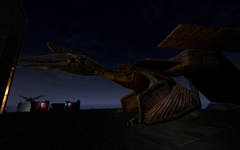
Quetzal with platform at Night
-
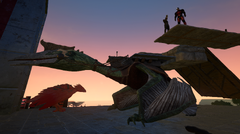
ASIG Size Comparison
-

Tek Quetzal
References [ ]
- ↑ ARK Smart Breeding
- ↑ Quetzal-taming with a Tapejara
- ↑ Quetzal Cage Strategy
- ↑ Solo Quetz Tame with Grappling Hook
- ↑ Jat (17 June 2015). "Introducing the Quetzalcoatlus!". Announcements. ARK: Survival Evolved Steam Community. Retrieved September 17, 2015.
- ↑ https://en.wikipedia.org/wiki/Quetzalcoatlus
| v · d · e Creatures | |||||||||||||||||||||||||||||||||||||||||||||||||||||||||||
|---|---|---|---|---|---|---|---|---|---|---|---|---|---|---|---|---|---|---|---|---|---|---|---|---|---|---|---|---|---|---|---|---|---|---|---|---|---|---|---|---|---|---|---|---|---|---|---|---|---|---|---|---|---|---|---|---|---|---|---|
| |||||||||||||||||||||||||||||||||||||||||||||||||||||||||||
Adding Movement Speed Back to Flying Dinos Ark
Source: https://ark.fandom.com/wiki/Quetzal


































































































































































































































































0 Response to "Adding Movement Speed Back to Flying Dinos Ark"
Postar um comentário